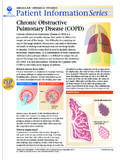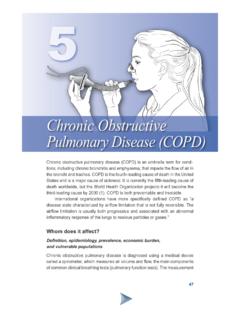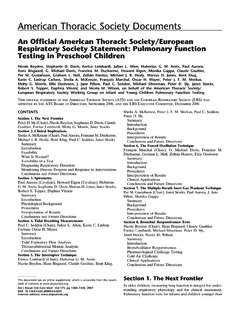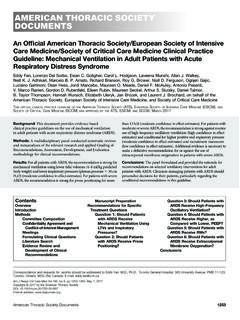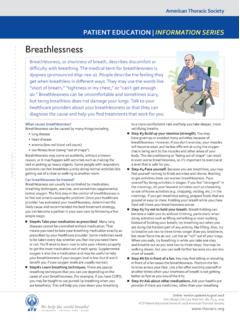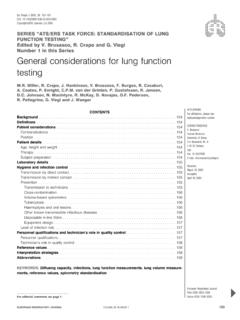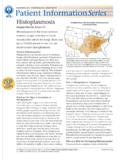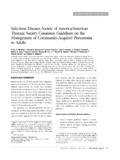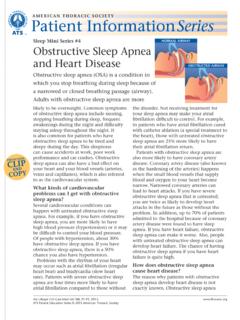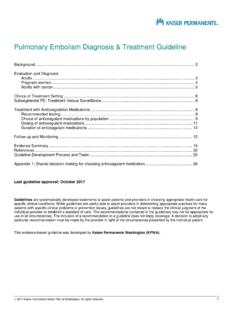Transcription of Diagnosis of Idiopathic Pulmonary Fibrosis
1 AMERICAN THORACIC SOCIETYDOCUMENTSD iagnosis of Idiopathic Pulmonary FibrosisAn Official ATS/ERS/JRS/ALAT Clinical Practice GuidelineGanesh Raghu, Martine Remy-Jardin, Jeffrey L. Myers, Luca Richeldi, Christopher J. Ryerson, David J. Lederer,Juergen Behr, Vincent Cottin, Sonye K. Danoff, Ferran Morell, Kevin R. Flaherty, Athol Wells, Fernando J. Martinez,Arata Azuma, Thomas J. Bice, Demosthenes Bouros, Kevin K. Brown, Harold R. Collard, Abhijit Duggal, Liam Galvin,Yoshikazu Inoue, R. Gisli Jenkins, Takeshi Johkoh, Ella A. Kazerooni, Masanori Kitaichi, Shandra L. Knight,George Mansour, Andrew G.
2 Nicholson, Sudhakar N. J. Pipavath, Ivette Buend a-Rold an, Mois es Selman,William D. Travis, Simon L. F. Walsh, and Kevin C. Wilson; on behalf of the American Thoracic Society, EuropeanRespiratory Society, Japanese Respiratory Society, and Latin American Thoracic SocietyTHIS OFFICIAL CLINICAL PRACTICE GUIDELINE OF THEAMERICANTHORACICSOCIETY(ATS), EUROPEANRESPIRATORYSOCIETY(ERS), JAPANESERESPIRATORYSOCIETY(JRS),ANDLATIN AMERICANTHORACICSOCIETY(ALAT)WAS APPROVED BY THEATS, JRS,ANDALAT MAY2018,AND THEERS JUNE2018 Background:This document provides clinical recommendationsfor the Diagnosis of Idiopathic pulmonaryfibrosis (IPF).
3 It representsa collaborative effort between the American Thoracic Society,European Respiratory Society, Japanese Respiratory Society, andLatin American Thoracic :The evidence syntheses were discussed andrecommendations formulated by a multidisciplinary committee ofIPF experts. The evidence was appraised and recommendationswere formulated, written, and graded using the Grading ofRecommendations, Assessment, Development, and :The guideline panel updated the diagnostic criteria for defined patterns of usual interstitial pneumonia (UIP)were refined to patterns of UIP, probable UIP, indeterminate for UIP,and alternate Diagnosis .
4 For patients with newly detected interstitiallung disease (ILD) who have a high-resolution computedtomography scan pattern of probable UIP, indeterminate for UIP, oran alternative Diagnosis , conditional recommendations were madefor performing BAL and surgical lung biopsy; because of lack ofevidence, no recommendation was made for or against performingtransbronchial lung biopsy or lung cryobiopsy. In contrast, forpatients with newly detected ILD who have a high-resolutioncomputed tomography scan pattern of UIP, strongrecommendations were made against performing surgical lungbiopsy, transbronchial lung biopsy, and lung cryobiopsy, and aconditional recommendation was made against performingBAL.
5 Additional recommendations included a conditionalrecommendation for multidisciplinary discussion and a strongrecommendation against measurement of serum biomarkers forthe sole purpose of distinguishing IPF from other :The guideline panel provided recommendationsrelated to the Diagnosis of : Idiopathic pulmonaryfibrosis; interstitial lung disease;pulmonaryfibrosisAn Executive Summary of this document is available at IDs: 0000-0001-7506-6643 ( ); 0000-0001-8247-3028 ( ); 0000-0001-8594-1448 ( ); 0000-0001-5258-0228 ( );0000-0002-9151-4829 ( ); 0000-0002-5591-0955 ( ); 0000-0001-9172-8977 ( ); 0000-0002-7206-4543 ( ); 0000-0003-2657-1314 ( ); 0000-0003-2108-6248 ( ); 0000-0002-2412-3182 ( ); 0000-0001-7300-3219 ( ); 0000-0002-0685-0765 ( );0000-0002-8558-6711 ( ); 0000-0003-4220-2359 ( ); 0000-0001-5859-8744 ( ); 0000-0003-3257-102X ( ); 0000-0001-6948-2376 ( ); 0000-0002-8230-0749 ( ); 0000-0002-1022-4783 ( ); 0000-0003-3160-6729 ( ); 0000-0003-0497-5297 ( ); 0000-0003-4429-2263 ( ).
6 Correspondence and requests for reprints should be addressed to Ganesh Raghu, , Center for Interstitial Lung Diseases, University of Washington, 1959 NEPacific Street, Seattle, WA 98195. E-mail: article has an online supplement, which is accessible from this issue s table of contents at J Respir Crit Care Med Vol 198, Iss 5, pp e44 e68, Sep 1, 2018 Copyright 2018 by the American Thoracic SocietyDOI: address: Journal of Respiratory and Critical Care Medicine Volume 198 Number 5|September 1 2018 ContentsSummary of RecommendationsIntroductionMethodsClinic al ManifestationsDiagnosisHRCT TechniqueHRCT Features of the UIPP atternHRCT PatternsSLB TechniqueHistopathology Features of theUIP PatternHistopathology PatternsDiagnostic Criteria for IPFD iagnostic InterventionsQuestion 1.
7 Should Patients withNewly Detected ILD ofUnknown Cause Who AreClinically Suspected of HavingIPF Undergo a Detailed,Prompted History ofMedication Use andEnvironmental Exposures atHome, Work, and Other Placesthe Patient Frequently Visits toExclude Potential Causes ofthe ILD?Question 2: Should Patientswith Newly Detected ILD ofUnknown Cause Who AreClinically Suspected of HavingIPF Undergo SerologicalTesting to Exclude CTDs asPotential Causes of the ILD?Question 3: Should Patientswith Newly Detected ILD ofUnknown Cause Who AreClinically Suspected of HavingIPF Undergo Cellular Analysisof Their BAL Fluid?
8 Question 4: For Patients withNewly Detected ILD ofUnknown Cause Who AreClinically Suspected ofHaving IPF, Should SLB BePerformed to Ascertain theHistopathology Diagnosis ofUIP Pattern?Question 5: For Patients withNewly Detected ILD ofUnknown Cause Who AreClinically Suspected of HavingIPF, Is TBBx a ReasonableAlternative to SLB to Ascertainthe Histopathology Diagnosisof UIP Pattern?Question 6: For Patients withNewly Detected ILD ofUnknown Cause Who AreClinically Suspected of HavingIPF, Is Transbronchial LungCryobiopsy a ReasonableAlternative to SLB to Ascertainthe Histopathology Diagnosisof UIP Pattern?
9 Question 7: Should Patientswith Newly Detected ILD ofUnknown Cause Who AreClinically Suspected of HavingIPF Be the Subject of MDD forDecision-Making?Question 8: Should Patientswith Newly Detected ILD ofUnknown Cause Who AreClinically Suspected of HavingIPF Undergo Serum Biomarker(MMP-7, SPD, CCL-18,KL-6) Measurement for thePurpose of Diagnosis ?Future Directions and ResearchQuestionsClinical ObservationsHRCTBAL and Transbronchial LungBiopsy via FiberopticBronchoscopyLung CryobiopsyHistopathologyEmpiric TherapyGenetic Markers and CounselingOther BiomarkersConclusionsSummary ofRecommendationsAdult patients with newly detected interstitiallung disease (ILD) of apparently unknowncause are clinically suspected of havingidiopathic pulmonaryfibrosis (IPF) if they haveunexplained symptomatic or asymptomaticpatterns of bilateralfibrosis on a chestradiograph or chest computed tomography(CT)
10 Scan, bibasilar inspiratory crackles, and anage typically older than 60 years. Rarely, middle-aged adults (.40 yr and,60 yr), especiallythose with risks for familial pulmonaryfibrosis,may otherwise manifest the same clinicalscenario as the typical patient older than60 years. The recommendations in this guidelineare for the patterns and distributions of imagesobtained by high-resolution CT (HRCT)imaging and, thus, require that patients besubjected to HRCT of the chest for adult patients with newly detectedILD of apparently unknown cause whoare clinically suspected of having IPF:dWe recommend taking a detailedhistory of both medication use andenvironmental exposures at home, work,and other places the patient frequentlyvisits to exclude potential causes of ILD(motherhood statement).
